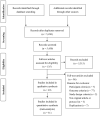What Kind of Intervention Is Effective for Improving Subjective Well-Being Among Workers? A Systematic Review and Meta-Analysis of Randomized Controlled Trials
- PMID: 33281653
- PMCID: PMC7691289
- DOI: 10.3389/fpsyg.2020.528656
What Kind of Intervention Is Effective for Improving Subjective Well-Being Among Workers? A Systematic Review and Meta-Analysis of Randomized Controlled Trials
Erratum in
-
Corrigendum: What kind of intervention is effective for improving subjective well-being among workers? A systematic review and meta-analysis of randomized controlled trials.Front Psychol. 2023 Jul 3;14:1236746. doi: 10.3389/fpsyg.2023.1236746. eCollection 2023. Front Psychol. 2023. PMID: 37469895 Free PMC article.
Abstract
Objectives: This study aimed to conduct a systematic review and meta-analysis of randomized controlled trials (RCTs) to improve subjective well-being (SWB), including evaluative, hedonic, and eudemonic well-being, and the mental component of quality of life (QOL) of working population. Methods: A literature search was conducted, using PubMed, Embase, PsycINFO, and PsycARTICLES. Eligible studies included those that were RCTs of any intervention, conducted among healthy workers, measured SWB as a primary outcome, and original articles in English. Study characteristics, intervention, outcomes, and results on SWB outcomes were extracted by the investigators independently. After a brief narrative summarizing and classifying the contents of the interventions, the included outcomes were categorized into each aspect of SWB (evaluative, hedonic, and eudemonic well-being, and the mental component of QOL). Finally, the characteristics of the effective interventions for increasing each aspect were summarized, and the pooled effect of interventions on SWB was investigated by a meta-analysis. Publication bias was investigated by drawing a funnel plot and conducting Egger's test. Results: From the 5,450 articles found, 39 met the inclusion criteria for the systematic review. The interventions included in this review were classified into six categories (physical activity, ergonomics, psychological, environmental, multicomponent intervention, and others). The meta-analysis from 31 studies showed that the pooled effect of included interventions on SWB was significantly positive (standardized mean difference (SMD) = 0.51; standard error (SE) = 0.10). A funnel plot showed there were extremely large or small SMDs, and Egger's test was significant. Thus, we conducted sensitivity analysis, excluding these extreme SMDs, and confirmed that the estimated pooled effect was also significantly positive. Subgroup analyses for separate types of interventions showed the effects of psychological interventions (e.g., mindfulness, cognitive behavioral based approach, and other psychological interventions) were also significantly positive. Conclusion: The current study revealed the effectiveness of interventions for increasing SWB. Specifically, psychological interventions (e.g., mindfulness, cognitive behavioral based approach, and other psychological interventions) may be useful for improving SWB.
Keywords: intervention; meta-analysis; positive mental health; subjective well-being; systematic review; worker.
Copyright © 2020 Sakuraya, Imamura, Watanabe, Asai, Ando, Eguchi, Nishida, Kobayashi, Arima, Iwanaga, Otsuka, Sasaki, Inoue, Inoue, Tsuno, Hino, Shimazu, Tsutsumi and Kawakami.
Conflict of interest statement
The authors declare that the research was conducted in the absence of any commercial or financial relationships that could be construed as a potential conflict of interest.
Figures



References
-
- Alhassan R. K., Nketiah-Amponsah E., Spieker N., Arhinful D. K., Rinke de Wit T. F. (2016). Assessing the impact of community engagement interventions on health worker motivation and experiences with clients in primary health facilities in ghana: a randomized cluster trial. PLoS ONE 11:e0158541. 10.1371/journal.pone.0158541 - DOI - PMC - PubMed
-
- Allexandre D., Bernstein A. M., Walker E., Hunter J., Roizen M. F., Morledge T. J. (2016). A web-based mindfulness stress management program in a corporate call center: a randomized clinical trial to evaluate the added benefit of onsite group support. J. Occup. Environ. Med. 58, 254–264. 10.1097/JOM.0000000000000680 - DOI - PMC - PubMed
-
- Assink M., Wibbelink C. J. (2016). Fitting three-level meta-analytic models in R: A step-by-step tutorial. Quant. Methods Psychol. 12, 154–174. 10.20982/tqmp.12.3.p154 - DOI
Publication types
LinkOut - more resources
Full Text Sources
Miscellaneous

